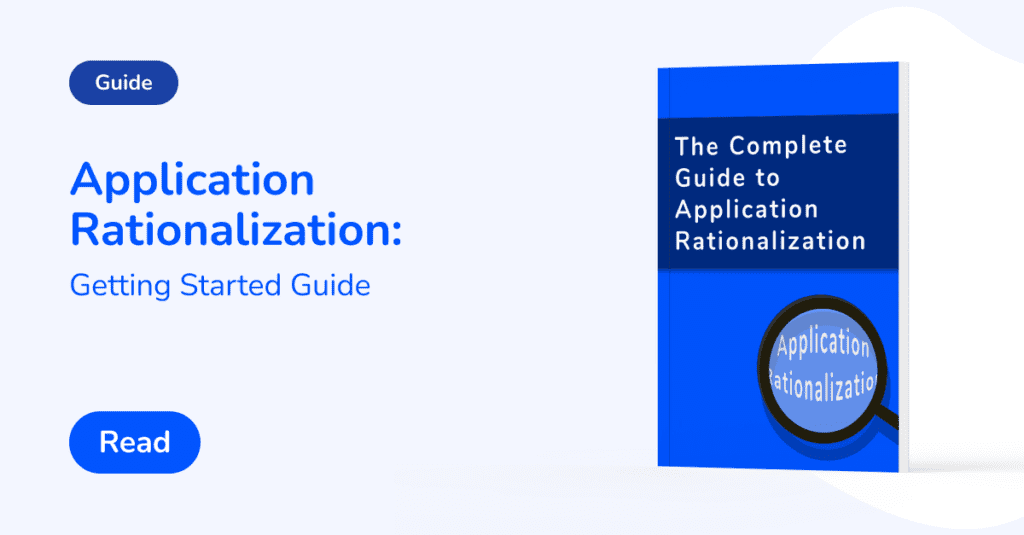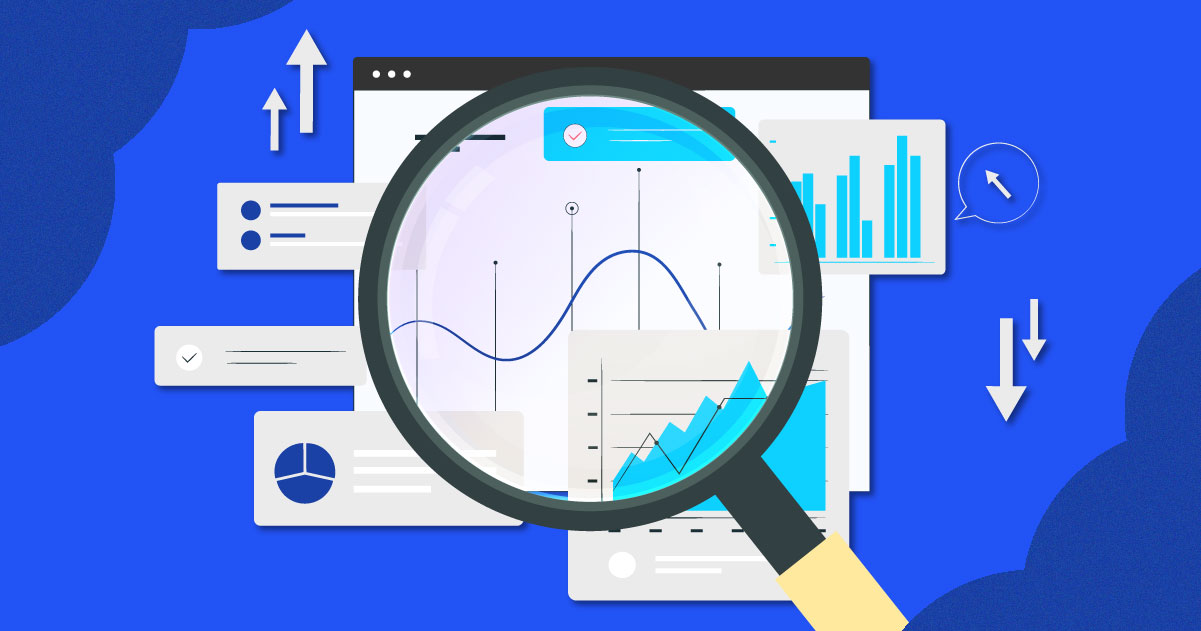In today’s evolving technology landscape, businesses are reliant on multiple applications to drive operations and deliver value to customers. However, with so many applications, companies experience increased costs and inefficiencies. As a result, application rationalization is a crucial practice for organizations. In this article, we break down the importance of app rationalization. Particularly how it improves business value by aligning your application portfolio business goals.
Ready to get started with application rationalization?
Check out our 6 step guide to help you get started today!

What is Application Rationalization?
Application rationalization is the systematic process of reviewing and evaluating an organization’s application portfolio. Simply put, every app should either be kept, replaced, or retired. App rationalization requires a level of ruthless analysis of the value of the app in question. The ultimate aim of this practice is to align the tools with the goals of the organization. Which, in turn, eliminates redundancies and cuts costs.
Connection to Application Portfolio Management
Application rationalization is a vital component of application portfolio management, which involves overseeing all applications within an organization to ensure they provide business value. By active application portfolio rationalization, you make it easier to manage and can more effectively prioritize investments in applications that align with your business needs and goals.
The Growing Problem: Application Sprawl
Application Sprawl refers to the unsanctioned spread of applications across an organization, often in the form of shadow IT. It often results in overlap, redundancy, and complications in management. Application sprawl creates many issues, including:
Excessive Cost
The financial burden of maintaining multiple, often redundant, applications is significant. Licenses, server costs, and manpower for maintenance add up, straining the organization’s budget.
Inefficiencies
The lack of a streamlined application landscape can cause operational inefficiencies. Employees may struggle with multiple interfaces, different data formats, and inconsistent user experiences, impacting productivity and business processes.
Security Concerns
More apps equals more surface area for cyber threats. With more applications, IT, security, and compliance teams will have more to monitor. Add to that the fact that each app will often add new integrations, and a scary picture begins to emerge.
How SaaS Management Enables App Rationalization
SaaS management tools such as Torii provide a unified dashboard where you can get an at-a-glance view of all the apps your business uses. This is essentially your application inventory, your system of record, a vital first step in the rationalization process. With the SaaS management platform, you can easily identify redundant applications, underutilized licenses, and any software that is not compliant with company policy.
More importantly, SaaS management platforms provide analytics that aid in making informed decisions. These metrics can include usage statistics, cost implications, and how each application aligns with your business objectives. Using this data, companies can determine which applications are crucial for operations, which are nice-to-have, and which are simply redundant or unnecessary.
By leveraging the capabilities of SaaS management, organizations can execute a more effective and data-driven application rationalization strategy. This leads to significant cost savings, enhanced efficiency, and a software portfolio that is fully aligned with the company’s business goals. Thus, SaaS management doesn’t just support application rationalization; it enables it.
Enterprise Architecture and Its Role in Application Rationalization
Enterprise Architecture is the practice of designing, implementing, and governing the architecture of an organization’s applications, data, and technology. It plays a vital role in shaping how individual applications fit into the broader business and technology landscape.
Role of an Enterprise Architect in Rationalization Efforts
The Enterprise Architect is instrumental in application rationalization initiatives. They assess the application portfolio against the backdrop of organizational strategies and business goals. Their insights help in identifying redundancies, gaps, and opportunities for consolidation, thereby ensuring that rationalization efforts are aligned with the enterprise strategy.
The Application Portfolio: An Asset or a Liability?
An organization’s application portfolio consists of all the software applications that are used to meet business needs. Managed correctly, this portfolio can be a strategic asset; if managed poorly, it becomes a liability.
Concepts of Asset Management and Technical Debt Within the Portfolio
Asset Management in this context involves tracking and managing the value each application brings to the organization. Knowing the value and lifecycle stage of each application aids in more effective decision-making during rationalization efforts.
Technical Debt refers to the future costs incurred by choosing quick-and-easy solutions today rather than the better approach that may take longer. In an application portfolio, technical debt could mean sticking with legacy applications that are costly to maintain and do not align with current business needs. Reducing this debt is one of the key outcomes of a successful application rationalization initiative.
Key Steps in the Application Rationalization Process
Successfully rationalizing your application portfolio involves a structured approach. Here are the key steps in the application rationalization process:
Identification of Existing Applications and Application Inventory
The first step involves creating an inventory of all existing applications within the organization. This comprehensive list serves as the basis for all subsequent rationalization efforts.
Elimination of Redundant Applications
Upon inventory completion, identify applications that serve similar purposes. Eliminating these redundancies can result in immediate cost savings and simplified management.
Business and Technical Fit Analysis
Each remaining application should undergo a thorough evaluation to determine its alignment with both business needs and technical requirements. The goal is to retain only those applications that offer a strong fit on both fronts.
Importance of Business Process and Goals
Connection Between Application Rationalization and Business Process
Application Rationalization is not just a technical exercise; it also plays a vital role in optimizing business processes. By retaining only those applications that enhance workflow efficiency and meet business requirements, organizations can streamline operations and improve overall performance.
How Rationalization Aligns with Business Goals
The ultimate aim of application rationalization is to align the application portfolio with organizational objectives. Through this alignment, businesses can ensure that resources are invested in applications that directly contribute to achieving strategic goals, such as increasing market share or enhancing customer experience.
Legacy Applications vs Modernization
Challenges with Legacy Applications
Legacy applications, often built on outdated technology, pose multiple challenges. They are typically expensive to maintain, difficult to integrate with newer systems, and often lack the features required to meet current business needs.
Importance of Application Modernization in Rationalization
Application Modernization is crucial in turning these liabilities into assets. By modernizing legacy systems, organizations can reduce maintenance costs, improve functionality, and ensure that their application landscape is in sync with current and future business requirements. Modernization thus plays a pivotal role in the success of an application rationalization initiative.
Managed Services and Professional Services
Explanation of How Managed and Professional Services Can Assist
Managed Services and Professional Services can provide specialized skills and expertise that may not be available in-house. These services often offer end-to-end solutions for application rationalization, from initial assessments to implementation.
Case for Outsourcing Rationalization
Outsourcing the rationalization process to experts allows organizations to accelerate time-to-value and minimize risks. With a third-party focus solely on rationalization, internal teams are free to concentrate on core business tasks, providing a compelling case for outsourcing this complex process.
Cost Savings and Efficiency
Explanation of How Rationalization Leads to Cost Savings
Application Rationalization directly contributes to cost savings by eliminating redundant applications, reducing license fees, and lowering maintenance costs. Furthermore, streamlined application portfolios are easier and less costly to manage.
Link Between Rationalization and Efficiency
Efficiency gains are another significant benefit of rationalization. By eliminating redundant and misaligned applications, employees can work more effectively, leading to increased productivity and better utilization of resources.
Stakeholder Engagement and Customer Success
Role of Stakeholders Such as the Application Owner and Portfolio Managers
Stakeholders like Application Owners and Portfolio Managers play crucial roles in rationalization efforts. Their insights into application usage, business needs, and strategic alignment are invaluable for making informed decisions.
Presentation of a Success Story to Illustrate Customer Success
A global manufacturing company faced challenges with an oversized application portfolio, leading to high costs and reduced agility. Through a focused application rationalization initiative, involving key stakeholders and leveraging managed services, the company managed to eliminate 30% of redundant applications within a year. This resulted in an annual cost saving of 20% in application maintenance and led to a more agile and responsive application landscape. This serves as a compelling success story for the significant advantages that rationalization can bring.
Application Rationalization in the Public Sector
Special Considerations for Rationalization in the Public Sector
In the public sector, application rationalization takes on added layers of complexity due to regulatory constraints, data sensitivity, and the need for public accountability. Rationalization initiatives here must also consider the impact on citizens and how service delivery may be affected. The focus often extends beyond cost savings to include aspects like data security, compliance, and public service optimization.
Making Informed Decisions Through Business and Technical Architecture
Business Architecture and Its Relevance
Business Architecture provides a strategic framework that aligns an organization’s business functions, processes, and objectives. It serves as a guidepost in the application rationalization process, helping to identify which business applications support key business activities and objectives.
Making Informed Decisions Through Accurate Data
Data-driven decision-making is crucial for successful rationalization. Accurate data on application performance, costs, and business impacts allows organizations to make informed decisions that align with their strategic goals and business architecture.
Conclusion
Summary of the Article
This article has explored the multifaceted process of application rationalization, covering its significance, key steps, and benefits. We’ve delved into the roles of various stakeholders, the impact on business processes, and the importance of aligning your application portfolio with your organizational objectives.
Emphasis on the Business Value and Efficiency Gains from Application Rationalization
In conclusion, application rationalization is not merely a cost-saving exercise but a strategic initiative that boosts business value and operational efficiency. By meticulously auditing and aligning your application landscape, you can achieve significant gains in cost savings, efficiency, and business agility, ensuring that your technology investments are fully optimized.

